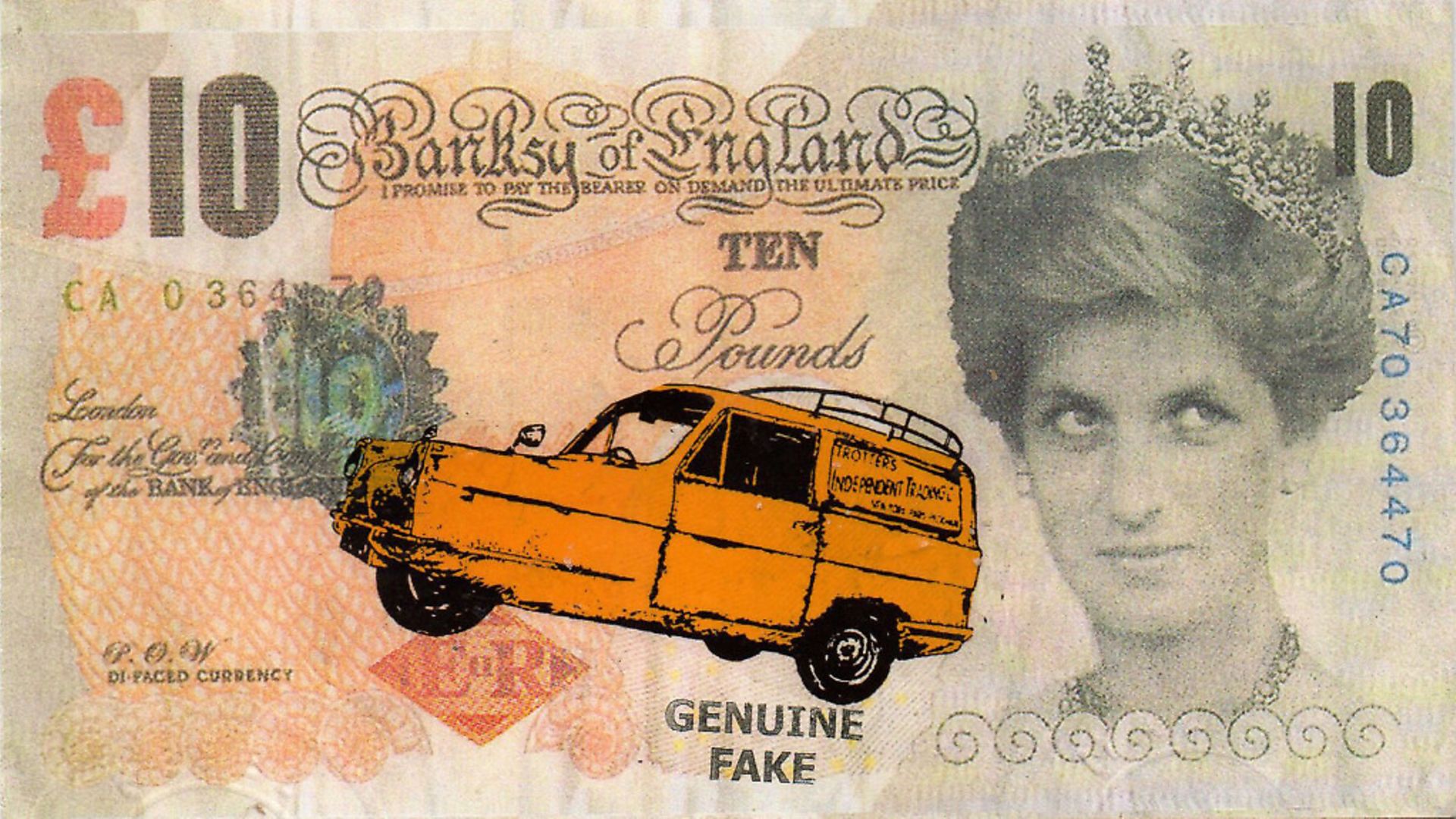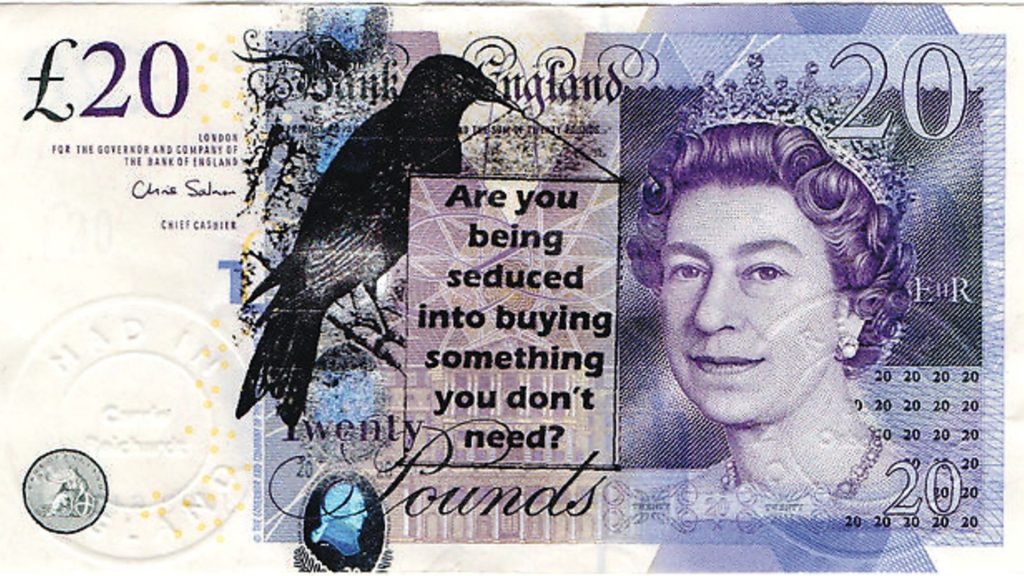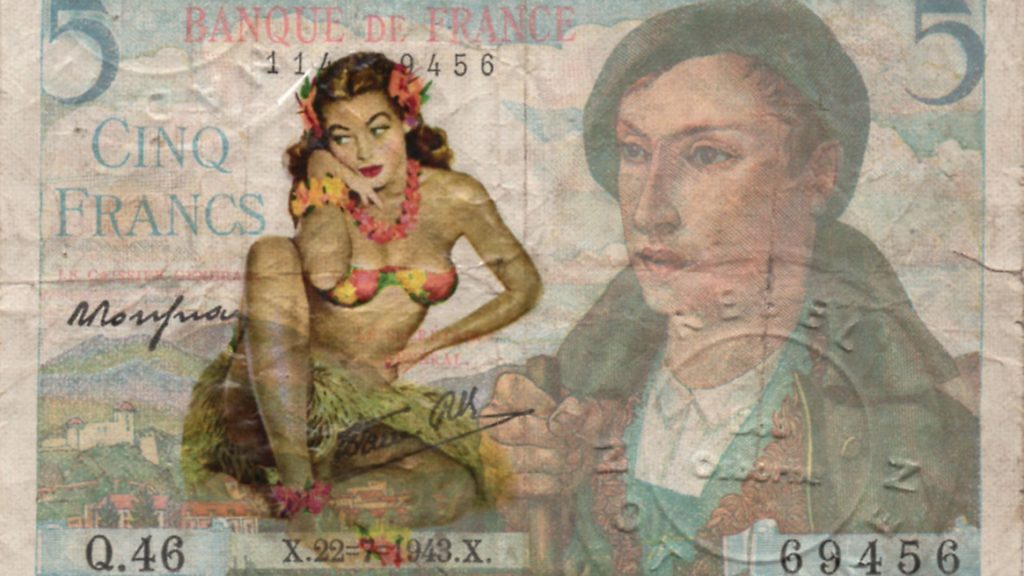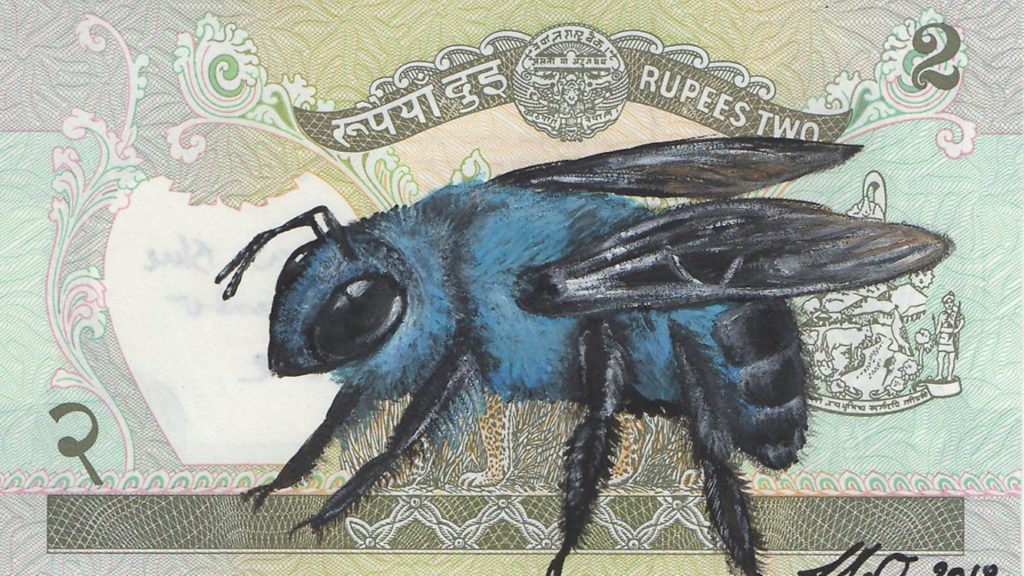
Adrian Burnham on a new exhibition which encourages us to see hard currency from a different perspective.

Cash is King, the book and exhibition at Saatchi Gallery is the brainchild of artists Robert Osborne and Carrie Reichardt. And they seem to have tapped into a multifarious protest aesthetic and potent form of dissent: one that manages to both piggyback and counter the sociopolitical symbolism being peddled by the bank, nation or ruler responsible for issuing the currency.
In the US you can stamp banknotes but you can’t advertise on them. In the UK it’s illegal to deface money but not to destroy it. In Australia it’s an offence both to disfigure and/or mutilate notes. Defacing money in Iraq could cost you up to a million dinars fine or six months in jail or both.
Since China’s Ming Dynasty issued the first bank note more than six centuries ago, paper money has been a tool of state control. Flash forward 500 years and you have the words ‘Votes for Women’ being stamped on the King’s coinage by suffragettes.
More recently we saw the socio-political defacement by the Occupy movement who stamped dollar bills with a message that the richest 400 people in the US hold wealth equal to the poorest 150 million. A big part of the reason for using currency as a canvas has to be its symbolic association with the rule of law and a wish to confront and contradict it.

So defacing/refacing money as an act allied to civil disobedience is a time-honoured tactic: a small but significant subversion aimed at centralised authority and intended to circulate a message of defiance and a call for change.
Economists consider money in terms of formalised liquidity, a state-instituted commodity – often steered and geared towards preserving private profit – that symbolises value and facilitates exchange. It is abstract and illusory: nowadays only 4% of money whizzing round the world exists in the material form of coins and notes. And if the current direction of flow persists, hard cash may become a thing of the past, thereby extinguishing a potent vehicle for expression and protest.
But when cash is abolished – that is, when governments feel compelled to adopt the micro-surveillance of all transactions – whatever’s left in circulation might then be used again as promissory notes to betoken goods or services due the holder: symbols of honest exchange rather than consumer society made manifest.
Not that contributors to Cash is King could give a monkey’s about bowing to the law. From the repeat-offender quipping visual hacks to the lovingly crafted, painstakingly produced one-off by an outsider artist; from appropriated fine art imagery to the scribble, sparse graphic and painterly, graffitied to figurative, Pop to fantastical, the irate, whimsical, personal, political… The many and varied contributions to Cash is King all cohere, on one level, as a two finger salute to control.

But who are we kidding? These days national capitalism is pretty much kaput? The era in which money is defined by the state is ebbing away. In its place a return to monetary plurality, an escalation of ways and means to acquire or exchange goods and services: from internet barter, electronic money, a proliferation of local currencies that seek to keep profits away from the grasping mitts of global operators.
Why, how then does defacing/refacing banknotes still pack a punch? Because money is not self-contained, as David Frisby notes in his introduction to G. Simmel’s Philosophy of Money: ‘Economic phenomena are no longer ‘economic facts’ but also posses psychological, ethical, aesthetic, historical, sociological and philosophical dimensions.’
Nigel Dodd, author of The Social Relations of Money, unpacks this further by suggesting money is a fluid, dynamic process rather than an objective entity. Again, these days money is not necessarily defined by the state, it often eludes legal or political control, ‘money is shaped by the social practices of its users’.
But an ugly fact remains and, if anything, seems to be getting worse: we live in societies where opportunity is stymied by extremes of unequal wealth. So while, as Dodd avers, ‘money can be celebrated as something joyful and irrational, emotional and personal’ it still retains potency as a symbol of our market economy: that elusive, faceless neoliberalism that can only ‘flourish’ with minimal control, beyond nation states and supposedly outwith politics. Though flourish is the wrong word. ‘Rigged’ to truly benefit just 1% seems closer to the mark.
As philosopher Michael Sandel put it, markets crowd out morality. ‘Part of the appeal of markets is that they don’t pass judgment on the preferences they satisfy. They don’t ask whether some ways of valuing goods are higher, or worthier than others. If someone is willing to pay for sex or a kidney, and a consenting adult is willing to sell, the only question the economist asks is, ‘How much?”
Defacing/refacing money slows it down. It ceases to function as the means of exchange, a mediator between objects, it becomes again recognisable as an object itself, and, often in contributions to Cash is King, a platform for objections to technocratic and managerial attitudes that afflict societies, both near and far.
In the UK it was fivers that were first to go plastic. Then, from July 2017 the substitution of paper tenners for polymer ones was another step away from the warmth, the history-bearing quality of paper. The new notes writhe and slip around like fortune-telling fish, all too keen to jump out of our pockets it seems.
Plastic doesn’t carry the patina of use the way paper does: those folds, smudges, more and less legible marks, even the smell of money. All this contributes to its palimpsestic quality. And that’s before we get to focus on these folk who purposely chose money as the vehicle for their artistic output.
In the case of Carrie Reichardt and Bob Osborne, phrases and motifs – ones already used both in their individual art practice and joint works produced on ceramic ware or printed ephemera – migrated over to make an appearance on banknotes.
Cash money was never far from the minds of Rodney and Del Boy of Only Fools and Horses sitcom fame – the sight of their three-wheeler van rocking with fresh millionaire’s glee outside Sotheby’s was a classic smiley tears television moment – so it seems fitting the yellow motor adorns a few notes.
Likewise, if not money itself but the love of it is the root of all evil, then conflating sexual exploitation with filthy lucre is a no-brainer. Hence the felicitous repeat use of ‘call girl’ card imagery in Mad in England and Rebel Not Taken’s contributions. Take the tenner with, instead of QEII’s regal rictus, Princess Di’s doe like eyes all aflutter, coupled with a text that was to be her fate: ‘MAID TO BE PUNISHED! NEW 18YR OLD’.
There’s a murky desperation in the inky graphic upskirt/tits-out/mouth agape decals coupled with ogling skulls and lascivious text. But jokey smut flips to incisive protest on notes that call out Oxfam workers’ sexual predation in blighted countries where selling your body isn’t a last resort but pretty much the only one if you’ve medicine to buy or a family to feed. It’s this context that reframes the economist’s bald, supposedly efficient, question, ‘How much?’ as reductive, deceptive, downright criminal at times.
On a cheerier note, what’s great about Cash is King isn’t just the array of works throughout the book or the promise of future exhibitions: it’s the global muster of image makers. Donations to the project have been superb, generous and dizzyingly wide-ranging. From Sax Impey’s FogBank of England that casts the UK monarch’s youthful face out to sea, up to her neck in the roiling black waters (an elegiac nod perhaps to fading empire and sea power, maybe?) to the funnier money that’s reached these shores. For example, sent from Cleveland, U.S., Josh Usmani’s exquisitely detailed psychedelic patterning. Maybe Her Maj should treat herself to an entheogenic trip or two: it might take her mind off the bonkers trajectory her beloved GB seems set on.
The range of media used to deface/reface money in Cash is King is a feast. Collage, stencils, lipsticked kisses, subversive stitchings: is Holly Searle allowed to refer to the Queen of England as ‘Vintage C***ge’? Shouldn’t she be in the Tower by now? But it’s not all seditious swipes. Serious points are made, too. Dotmaster’s addition of John Wayne on an Iraqi note that features a horseback charge and Saddam Hussein’s smarmy mug neatly alludes to foreign policy decisions that continue to unravel with disastrous consequences. Nina Ghafari’s raw, economic reface of a 500 Kroner note together with the words ‘No Human Being Is Illegal’ is a stark reminder that money travels easier than people fleeing war, famine or persecution. ATM’s ornithological wonders are charming, finely detailed works and when you realise his mission is to highlight endangered species the fact he’s chosen money as his canvas makes them all the more poignant. It is, after all, the pursuit of profit that more often than not threatens the natural habitats of these beautiful creatures.
Finally one of Reichardt and Osborne’s less lewd offerings sums up the bind of our consumer culture: blazoned on a freshly-minted score, the unfurled scroll in a crow’s beak reads: ‘Are you being seduced into buying something you don’t need?’ Economic sociologist Viviana Zelizer has argued for a typology of monies since it operates in multiple registers to the extent that people will ‘segregate, differentiate, label, decorate, and personalise it to meet their complex social needs’.
In Cash is King we see the gamut of social, political and aesthetic concerns rendered on banknotes from across the globe. Hard cash transformed into visual gifts. An exchange of imagery, ideas and wit that from their inception went against the rules and for that we’re all a little bit better off.
Cash Is King opens on August 30 at Saatchi Gallery, King’s Road, London SW3 4RY. The book can be ordered via www.rebelnottaken.com
Adrian Burnham writes on art and urban culture. He is founder and curator of www.flyingleaps.co.uk, a street poster and web platform for artists. Email him at info@flyingleaps.co.uk









